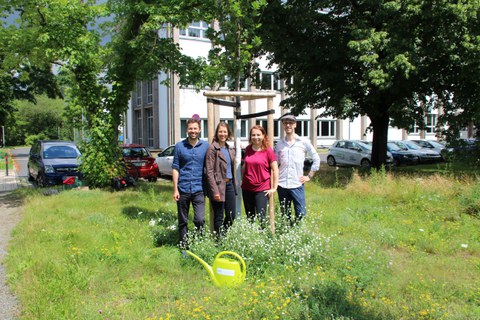Tree sponsorship Psychology study class Pedunculate oak
- Scientific name
- Quercus robur
- Planting
- 2021
- Tree sponsor
-
Prof. Angela Francke, Dr. Mathias Hofmann, Dr. Marleen Jacobi, Prof. Philipp Kanske, Dr. Doreen Reifegerste, Dr. Ulrike Rösler, Dr. Ines Thronicker
- Handed over on
- Sep 24, 2021
This tree was donated by former psychology students in memory of their time studying together.
Location
Did you know?
The pedunculate oak, also called English oak or common oak, is one of the characteristic trees of German woodlands. This tree species can become 500 to 800 years old and grow up to a height of 50 meters. In deciduous and mixed woods, it forms dense populations with hornbeam, birch or pine. It is planted as a single tree, in groups of trees and in hedges, and is often used for reforestation, greening and protective vegetation.
These long-lived, deep-rooted trees stand out due to their broad crown with strong branches and their dark gray bark with meshed cracks. Its taproot system reaches down deep and often reaches into the groundwater. As a tree with deep roots, it needs a lot of downward space.
Oak wood is valuable lumber and is mainly used in shipbuilding, construction and cabinet making. Oak bark, rich in tannins, used to be traded as tanbark. It is still used for tanning leather today. In the past, livestock, in particular pigs, were driven into the forest to be fattened on acorns. The nutritious acorns are still used today to feed pigs and game. They are an important food source for many species of birds and mammals. For example, jays and squirrels spread the pedunculate oak by creating food depots. The pedunculate oak also provides food and habitats for many insect species and their larvae. Eight species of wild bees feed on the pollen of the blossoms. The leaves are invaluable for butterflies, since they serve as caterpillar food for a total of 32 species.

